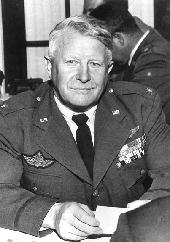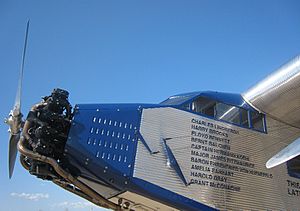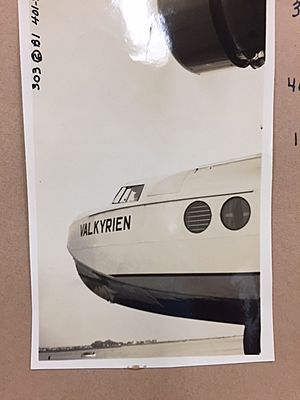Bernt Balchen facts for kids
Quick facts for kids
Bernt Balchen
|
|
|---|---|

Bernt Balchen, c. 1950
|
|
| Born | 23 October 1899 Tveit, Kristiansand, Norway
|
| Died | 17 October 1973 (aged 73) Mount Kisco, New York, U.S.
|
| Occupation | Aviator, navigator, engineer, military leader |
| Spouse(s) | Emmy Alvhilde (née Sorlie), Inger (née Engelbrethsen), and then Audrey (née Schipper) |
| Children | Bernt Jr, Lauritz |
| Parent(s) | Lauritz, Dagny (née Dietrechson) |
Bernt Balchen (born October 23, 1899 – died October 17, 1973) was a brave Norwegian pilot, navigator, and engineer. He was famous for his amazing flights in the polar regions. Later, he became an American citizen and earned the Distinguished Flying Cross for his courage.
During World War II, he used his special skills in Arctic exploration to help the Allies in Scandinavia and Northern Europe. After the war, Balchen continued to be an important leader with the U.S. Air Force. He also worked as a trusted expert on projects about the Arctic and flying.
Contents
Early Life and Adventures
Bernt Balchen was born in Tveit, near Kristiansand, Norway. His father was a country doctor. After finishing school in 1916, he studied forestry. In 1918, he joined the Norwegian Army.
Balchen was a very skilled athlete. He was a champion boxer and an expert marksman. He was also great at skiing and knew a lot about surviving in the wilderness. These skills would become very important in his later adventures. In 1921, he decided to become a pilot in the Royal Norwegian Navy Air Service.
Amazing Flights
Helping Roald Amundsen
In 1925, the Norwegian Defense Department chose Balchen for a special mission. He joined the Amundsen-Ellsworth Relief Expedition. This team went to Spitsbergen to rescue the famous explorer Roald Amundsen, who was missing. This trip made Amundsen a lifelong friend to Balchen.
The next year, Balchen helped Amundsen, Lincoln Ellsworth, and Umberto Nobile prepare for their Arctic Expedition. They planned to fly the airship Norge over the North Pole. Balchen taught the Italian crew members how to ski and survive in the cold. Even though he was a great mechanic, he wasn't chosen for the record-breaking flight.
Supporting Byrd's North Pole Flight
Balchen also helped another explorer, Lieutenant Commander Richard E. Byrd of the U.S. Navy. Byrd's plane, the Josephine Ford, had crashed. Balchen helped fix the damaged skis using oars from a lifeboat. He also loaned Byrd some survival gear. This help allowed Byrd and his pilot, Floyd Bennett, to fly to the North Pole and back in May 1926.
Later in 1926, Balchen joined Byrd's team as a co-pilot and navigator. They flew the Josephine Ford to over 50 American cities. This tour helped promote flying as a safe and practical way to travel. After this, Balchen became a test pilot for the Fokker Aircraft Company.
Flying Across the Atlantic
On June 29, 1927, Balchen was the co-pilot on a historic flight. He flew the Fokker trimotor America across the Atlantic Ocean. Commander Byrd was also on board. Bad weather made it hard to land in Paris. When they were low on fuel, Balchen decided to land the plane safely on the ocean near the coast of France. Everyone on board was safe.
The Bremen Rescue
In April 1928, a plane called the Bremen got stuck on Greenly Island, Canada. Its crew had just made the first non-stop flight across the Atlantic from Europe. Balchen and Floyd Bennett flew a Ford Trimotor to help them. Sadly, Bennett became very sick during the flight and passed away. Balchen flew the rest of the way alone. He received $10,000 for his effort, which he generously gave to Bennett's widow.
Flight Over the South Pole
On November 28–29, 1929, Balchen made history again. He was the chief pilot of a plane called the Floyd Bennett. He and his crew became some of the first people to fly over the South Pole. This flight was a huge achievement in aviation history.
Helping Amelia Earhart
In 1931, the famous pilot Amelia Earhart hired Balchen as an expert. She wanted to fly solo across the Atlantic. Balchen helped prepare her plane, a Lockheed Vega. He and his team added extra fuel tanks and new instruments. With these changes, Earhart successfully flew across the Atlantic in May 1932.
Work in Norway
In the mid-1930s, Balchen returned to Norway. He worked with Norwegian Airlines and helped create a Nordic Postal Union. He also helped Norway make an aviation agreement with the United States.
World War II Hero
In 1939, when the Soviet Union attacked Finland, Balchen was in Helsinki. He joined the Norwegian Air Force and went to the United States. His mission was to set up a training camp for Norwegian airmen and soldiers in Canada. He worked with Canadian officials to use the Toronto Island airport, which became known as "Little Norway". During the war, over 2,500 Norwegian pilots, navigators, and mechanics were trained there.
From 1940, Balchen also flew planes for the British. In 1941, he joined the U.S. Army Air Forces as a colonel. He helped build secret airfields in Greenland. These bases were important for flying fighter planes across the Atlantic and for searching for German submarines.
Between 1941 and 1943, Balchen trained his team in cold weather survival and rescue. They saved many downed airmen on the Greenland icecap. In May 1943, Balchen led a bombing raid that destroyed the last German outpost on Greenland. This stopped the Germans from sending fake radio messages and getting important weather reports.
Later, Balchen led "Operation Where and When" in Sweden. He used Douglas C-47 planes to help people escape the Nazis. His "Operation Balder" also evacuated thousands of Norwegians, Americans, and others from Sweden. His air operations also delivered important supplies, like ammunition, to the underground resistance in occupied Norway. He even paradropped a hospital with a doctor and nurse!
After the War
From 1948 to 1951, Balchen commanded the 10th Rescue Squadron of the U.S. Air Force in Alaska. He helped develop new ways to rescue people in cold weather. He also convinced the U.S. Air Force to buy the de Havilland Canada DHC-2 Beaver plane, which became a key rescue aircraft in the Arctic. In 1949, Balchen flew a Douglas C-54 Skymaster from Alaska, over the North Pole, to Thule Air Base in Greenland.
Balchen was very important in building the secret Thule Air Base in Greenland in 1951. This base helped the Strategic Air Command protect against threats during the Cold War.
Later Years
After retiring from the U.S. Air Force in 1956, Colonel Balchen continued to work as an expert for the Air Force and for aviation and energy companies. He worked on many different projects, from ice-breakers to new materials for submarines. He also believed that the North Pole was warming and that the Arctic Ocean might be ice-free by the year 2000.
In Norway, Balchen helped start Det Norske Luftfartselskap (D.N.L.), which was the Norwegian Airline Company. He helped create commercial flights between Europe and the U.S. over the North Pole. D.N.L. later joined with other airlines to form Scandinavian Airlines.
Death and Burial
Bernt Balchen worked as a consultant until he passed away from bone cancer in 1973 in Mount Kisco, New York. He was buried at the Arlington National Cemetery in Virginia, next to Admiral Richard E. Byrd.
Awards and Recognition
Balchen received many honors for his amazing achievements. He won the Harmon Trophy in aviation. In 1976, the "Bernt Balchen Award" was created in his memory to recognize airports that are excellent at controlling snow and ice. He was also inducted into the International Air & Space Hall of Fame.
United States Awards
 Distinguished Service Medal
Distinguished Service Medal Legion of Merit
Legion of Merit Distinguished Flying Cross
Distinguished Flying Cross Soldier's Medal
Soldier's Medal Air Medal
Air Medal Army Commendation Medal
Army Commendation Medal Byrd Antarctic Expedition Medal
Byrd Antarctic Expedition Medal American Defense Service Medal
American Defense Service Medal American Campaign Medal
American Campaign Medal European-African-Middle Eastern Campaign Medal
European-African-Middle Eastern Campaign Medal World War II Victory Medal
World War II Victory Medal National Defense Service Medal
National Defense Service Medal
International Awards
 Commander 1st Class The Royal Norwegian Order of St. Olav (Norway's highest civilian award)
Commander 1st Class The Royal Norwegian Order of St. Olav (Norway's highest civilian award) King Christian X's Liberty Medal (Denmark)
King Christian X's Liberty Medal (Denmark) Victory Medal (France)
Victory Medal (France) 1939–1945 Star (United Kingdom)
1939–1945 Star (United Kingdom) War Medal 1939–1945 (United Kingdom)
War Medal 1939–1945 (United Kingdom)
Civilian Awards
- New York City Medal of Valor - 2 awards
- City of Paris Gold Medal
Images for kids
-
Memorial plaque to Bernt Balchen in Kristiansand
See also
 In Spanish: Bernt Balchen para niños
In Spanish: Bernt Balchen para niños





